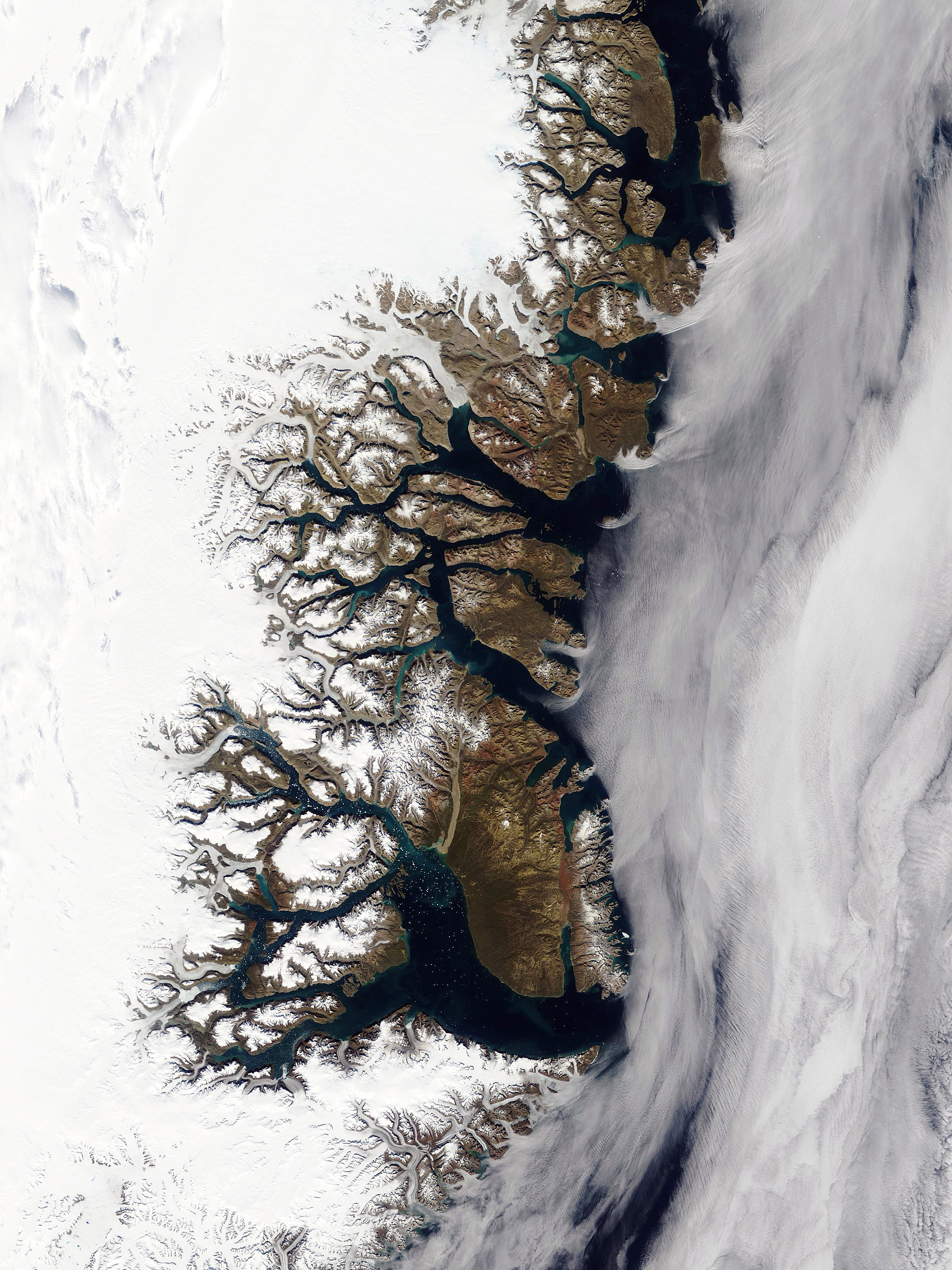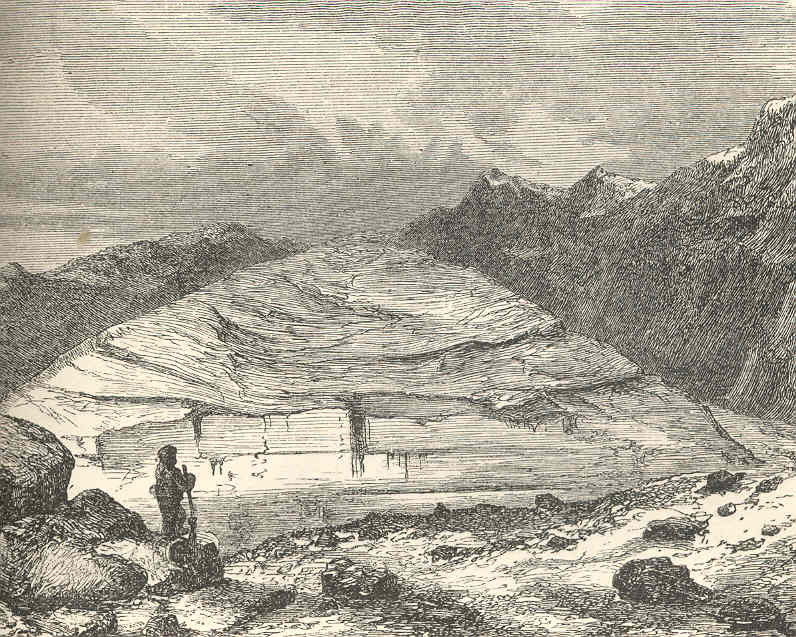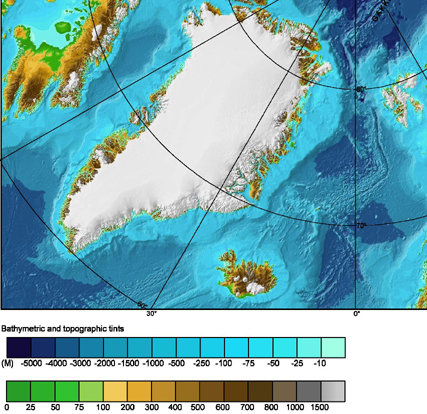|
Kuhn Island
Kuhn Island ( da, Kuhn Ø) is a coastal island in Hochstetter Bay, eastern Greenland. There are coal deposits on the island. The island was discovered by the Second German North Polar Expedition (1869-1870) and is named after Franz Kuhn von Kuhnenfeld, the Austro-Hungarian minister of war, who was a patron of the expedition's cartographer, Julius von Payer. Geography This island lies to the north of Wollaston Foreland, separated from Thomas Thomsen Land in the mainland by a narrow sound, the Fligely Fjord. The Lindeman Fjord has its mouth to the southwest and the Hochstetter Bay of the Greenland Sea lies to the east. The mouths of Ardencaple Fjord and Grandjean Fjord open to the north. The islands that are located further off the shore in the bay are Shannon Island to the NE and the Pendulum Islands to the SE. See also *List of islands of Greenland The following is an alphabetical list of the islands of Greenland. Many of these islands have both a Kalaallisut lang ... [...More Info...] [...Related Items...] OR: [Wikipedia] [Google] [Baidu] |
Franz Kuhn Von Kuhnenfeld
Franz Kuhn von Kuhnenfeld (15 July 1817 – 25 May 1896) was an Austro-Hungarian military officer who fought against Giuseppe Garibaldi in the wars of Italian independence and served as Imperial and Royal Minister of War from 1868 to 1874. During his term, a unified system of conscription for both Cisleithania (Austria proper) and Transleithania (Hungary and Croatia) was introduced, corporal punishment in military service was abolished, and the Franz-Josephinian Land Survey was initiated. He was a supporter of the Austro-Hungarian polar expedition and an opponent of the Austria-Hungary's 1879 alliance with the German Empire. Life Kuhn was born 15 July 1817 in Proßnitz, Moravia, Austrian Empire (now Prostějov in the Czech Republic), the son of Major Franz von Kuhn (1772-1842), who had been ennobled in 1823, and the farmer's daughter Johanna Schwab (1787-1856). He graduated with distinction from the Theresian Military Academy in Wiener Neustadt and entered military service ... [...More Info...] [...Related Items...] OR: [Wikipedia] [Google] [Baidu] |
Thomas Thomsen Land
Thomas may refer to: People * List of people with given name Thomas * Thomas (name) * Thomas (surname) * Saint Thomas (other) * Thomas Aquinas (1225–1274) Italian Dominican friar, philosopher, and Doctor of the Church * Thomas the Apostle * Thomas (bishop of the East Angles) (fl. 640s–650s), medieval Bishop of the East Angles * Thomas (Archdeacon of Barnstaple) (fl. 1203), Archdeacon of Barnstaple * Thomas, Count of Perche (1195–1217), Count of Perche * Thomas (bishop of Finland) (1248), first known Bishop of Finland * Thomas, Earl of Mar (1330–1377), 14th-century Earl, Aberdeen, Scotland Geography Places in the United States * Thomas, Illinois * Thomas, Indiana * Thomas, Oklahoma * Thomas, Oregon * Thomas, South Dakota * Thomas, Virginia * Thomas, Washington * Thomas, West Virginia * Thomas County (other) * Thomas Township (other) Elsewhere * Thomas Glacier (Greenland) Arts, entertainment, and media * ''Thomas'' (Burton novel) 1 ... [...More Info...] [...Related Items...] OR: [Wikipedia] [Google] [Baidu] |
Operational Navigation Chart B-9, 1st Edition
An operational definition specifies concrete, replicable procedures designed to represent a construct. In the words of American psychologist S.S. Stevens (1935), "An operation is the performance which we execute in order to make known a concept." For example, an operational definition of "fear" (the construct) often includes measurable physiologic responses that occur in response to a perceived threat. Thus, "fear" might be operationally defined as specified changes in heart rate, galvanic skin response, pupil dilation, and blood pressure. Overview An operational definition is designed to model or represent a concept or theoretical definition, also known as a construct. Scientists should describe the operations (procedures, actions, or processes) that define the concept with enough specificity such that other investigators can replicate their research. Operational definitions are also used to define system states in terms of a specific, publicly accessible process of preparation ... [...More Info...] [...Related Items...] OR: [Wikipedia] [Google] [Baidu] |
Pendulum Islands
Little Pendulum Island ( da, Lille Pedulum Ø) is an island in Eastern Greenland, in the Northeast Greenland National Park. History The island was named by Douglas Charles Clavering’s 1823 expedition, during which the Irish scientist Edward Sabine swung the pendulum on the largest of the islands (Sabine Island). Geography Little Pendulum Island is located to the north east of Wollaston Foreland, and to the south of Shannon Island. Together with Sabine Island (formerly Inner Pendulum Island) and an islet named Walrus Island ( da, Hvalros Ø) south of Sabine, it constitutes the Pendulum Islands. See also *List of islands of Greenland The following is an alphabetical list of the islands of Greenland. Many of these islands have both a Kalaallisut language name and a European language name. Islands and archipelagoes * Aaluik * Aasiaat Archipelago *Achton Friis Islands * Agg ... References Uninhabited islands of Greenland {{Greenland-geo-stub ... [...More Info...] [...Related Items...] OR: [Wikipedia] [Google] [Baidu] |
Shannon Island
Shannon Island ( da, Shannon Ø) is a large island in Northeast Greenland National Park in eastern Greenland, to the east of Hochstetter Foreland, with an area of . It was named by Douglas Charles Clavering on his 1823 expedition for the Royal Navy frigate HMS Shannon (1806), HMS ''Shannon'', a 38 gun frigate on which he served as midshipman under Sir Philip Broke. The island is also home to many different types of animals such as polar bears, walruses, ravens, and oxen. History Most landmarks in the area were named by the Second German Polar Expedition under Carl Koldewey in 1869–70. Between October 1943 and June 1944, the German meteorological expedition ''Bassgeiger'' operated under difficult conditions at Kap Sussi on Shannon. Their ship ''Coburg'' was wrecked off Shannon. The station was discovered by hunters, but the crew was evacuated by air to Norway. The island is the site of several hunter's cabins and is reputed to have especially favorable ice conditions. Geograph ... [...More Info...] [...Related Items...] OR: [Wikipedia] [Google] [Baidu] |
Grandjean Fjord
Grandjean Fjord is a fjord in King Christian X Land, East Greenland. Administratively it is part of the Northeast Greenland National Park zone. History This fjord was mapped in 1932 during the Three-year Expedition to East Greenland led by Lauge Koch. In August of the same year it was surveyed by Gunnar Seidenfaden. Koch named it after Commander Emil Valdemar Asger Grandjean (1889–1948), then chief of the Royal Danish Navy Air Service Geography Grandjean Fjord opens to the east, between Cape Negri to the south and Cape Buch to the north. Its mouth is located in the northwestern area of Hochstetter Bay, by the northern entrance of Fligely Fjord, northwest of Kuhn Island and south of the mouth area of Ardencaple Fjord. Ulla Island rises in the middle of mouth area of the fjord, about from the entrance. The fjord is about wide at the mouth and stretches to the southwest for about , curving northwestwards and narrowing to about in its inner half where the Heinkel Glacie ... [...More Info...] [...Related Items...] OR: [Wikipedia] [Google] [Baidu] |
Ardencaple Fjord
Ardencaple Fjord is a fjord in King Christian X Land, northeastern Greenland. Administratively it is part of the Northeast Greenland National Park. History Ardencaple Fjord was named by Douglas Clavering as "Ardencaple Inlet" in 1823, but the inner fjord would remain inaccessible for almost a century.''Catalogue of place names in northern East Greenland'', Geological Survey of Denmark (GEUS) The Second German Polar Expedition under Carl Koldewey in 1869-70 visited the area but could not enter the fjord on account of deep snow. In April 1908 the Denmark expedition sent and exploration team to survey Ardencaple Fjord, which had not yet been mapped because previous expeditions were not able to go beyond its mouth. Geography This fjord is located between Queen Margrethe II Land and C.H. Ostenfeld Land, west of Shannon Island. It divides in two fjord branches in its inner part, Bredefjord and Smallefjord. It runs roughly from northeast to west for about 50 km. Its mouth is in Hoch ... [...More Info...] [...Related Items...] OR: [Wikipedia] [Google] [Baidu] |
Lindeman Fjord
Lindeman Fjord is a fjord in King Christian X Land, East Greenland. Administratively it is part of the Northeast Greenland National Park zone. History The outer part of the fjord was first surveyed by Carl Koldewey during the 1869–70 Second German North Polar Expedition. Koldewey named it ''Lindeman Bai'' after Moritz Karl Adolf Lindeman (1823 – 1908), secretary of the Association for German Polar Exploration ''(Verein für die Deutsche Nordpolarfahrt)'' in Bremen. Later, during the 1929–1930 Expedition to East Greenland led by Lauge Koch, more thorough surveys were made and the fjord was found to become narrow to the west and extend further inland, thus the water body was renamed "Lindeman Fjord". Geography Lindeman Fjord opens to the east, southwest of Kuhn Island and south of the mouth area of Fligely Fjord. It extends southwest of Kuhn Island, west of Cape Schumacher at the southern end of the island. To the south lies A. P. Olsen Land and Thomas Thomsen Land lies t ... [...More Info...] [...Related Items...] OR: [Wikipedia] [Google] [Baidu] |
Fligely Fjord
Fligely Fjord is a fjord in King Christian X Land, East Greenland. Administratively it is part of the Northeast Greenland National Park zone. History The fjord was first surveyed by Carl Koldewey during the 1869–70 Second German North Polar Expedition. Koldewey named it after Austrian cartographer Field Marshal August von Fligely (1810–1879). There are a number of hunter cabins in the shores of the fjord. Geography Fligely Fjord is a marine channel with a fjord structure that stretches west of Kuhn Island and north of the mouth area of Lindeman Fjord. It forms the western shore of the island and to the west the eastern shore of Thomas Thomsen Land. The mouth of Grandjean Fjord lies west of the fjord's northern end. The fjord is about wide in its widest part and stretches from north to south for about .''Prostar Sailing Directions 2005 Greenland and Iceland Enroute'', p. 123 See also *List of fjords of Greenland This is a list of the most important fjords of Greenla ... [...More Info...] [...Related Items...] OR: [Wikipedia] [Google] [Baidu] |
Wollaston Foreland
Wollaston Foreland ( da, Wollaston Forland) is a peninsula in King Christian X Land, East Greenland. Administratively it belongs to the NE Greenland National Park area. History This peninsula was named by William Scoresby in 1822 as a testimony of respect to William Hyde Wollaston. It was also surveyed and explored by the Second German North Polar Expedition 1869–70 led by Carl Koldewey. The Danish Sirius Dog Sled Patrol has its headquarters at Daneborg on the southeastern shore. The Zackenberg research station is situated further West, near Young Sound. Geography Wollaston Foreland is bounded in the north by the Lindeman Fjord and Albrecht Bay of Hochstetter Bay, in the east by the Greenland Sea, in the south by the Young Sound and Gael Hamke Bay Gael Hamke Bay ( da, Gael Hamkes Bugt) is a large bay in King Christian X Land, East Greenland. Administratively it is part of the Northeast Greenland National Park zone. The bay was named after a Dutch skipper that claimed ... [...More Info...] [...Related Items...] OR: [Wikipedia] [Google] [Baidu] |
Greenland Sea
The Greenland Sea is a body of water that borders Greenland to the west, the Svalbard archipelago to the east, Fram Strait and the Arctic Ocean to the north, and the Norwegian Sea and Iceland to the south. The Greenland Sea is often defined as part of the Arctic Ocean, sometimes as part of the Atlantic Ocean. However, definitions of the Arctic Ocean and its seas tend to be imprecise or arbitrary. In general usage the term "Arctic Ocean" would exclude the Greenland Sea. In oceanographic studies the Greenland Sea is considered part of the Nordic Seas, along with the Norwegian Sea. The Nordic Seas are the main connection between the Arctic and Atlantic oceans and, as such, could be of great significance in a possible shutdown of thermohaline circulation. In oceanography the Arctic Ocean and Nordic Seas are often referred to collectively as the "Arctic Mediterranean Sea", a marginal sea of the Atlantic. The sea has Arctic climate with regular northern winds and temperatures rare ... [...More Info...] [...Related Items...] OR: [Wikipedia] [Google] [Baidu] |






